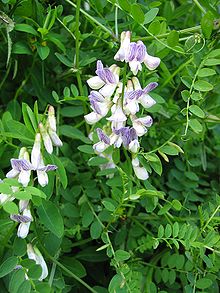Vicia sylvatica
Appearance
- This article is about the Vicia sylvatica described by Linnaeus. The plant thus named by Bentham is Vicia bakeri.
| Vicia sylvatica | |
|---|---|

| |
| Scientific classification | |
| Kingdom: | |
| (unranked): | |
| (unranked): | |
| (unranked): | |
| Order: | |
| Family: | |
| Genus: | |
| Species: | V. sylvatica
|
| Binomial name | |
| Vicia sylvatica | |
Wikimedia Commons has media related to Vicia sylvatica.
Vicia sylvatica or wood vetch is a plant species of the genus Vicia.
Description
This species is perennial with climbing stems. The leaves have 4 to 12 pairs of leaflets and end in branched tendrils. The flowers are 15 to 20 mm long arranged in racemes of up to 18 flowers. The petals are white with purple veins and the fruit is a pod or legume with 4 to 5 seeds.[1]: 158 [2]: 154 [3][4]
Habitat
Found in woods, rocky ground and scree.[5][4]
This section is empty. You can help by adding to it. (June 2014) |
Distribution
This species has been recorded from much of Ireland.[6]
References
- ^ Stace, C. A. (2010). New Flora of the British Isles (Third ed.). Cambridge, U.K.: Cambridge University Press. ISBN 9780521707725.
- ^ Blamey, M.; Fitter, R.; Fitter, A (2003). Wild flowers of Britain and Ireland: The Complete Guide to the British and Irish Flora. London: A & C Black. ISBN 978-1408179505.
- ^ Clapham, A.R.; Tutin, T.G.; Warburg, E.F. (1981). Excursion flora of the British Isles (Third ed.). Cambridge University Press. ISBN 9780521232906.
- ^ a b Webb, D.A.; Parnell, J.; Doogue, D. (1996). An Irish Flora. Dundalk: Dundalgan Press Ltd. ISBN 0-85221-131-7.
- ^ Hackney, P. ed. 1992. Stewart and Corry's Flora of the North-east of Ireland. Third Edition. Institute of Irish Studies. The Queen's University of Belfast. ISBN 0 85389 446 9
- ^ Scannell, M.J.P. and Synnott, D.M. 1972 Census Catalogue of the Flora of Ireland. Dublin. The Stationery Office
